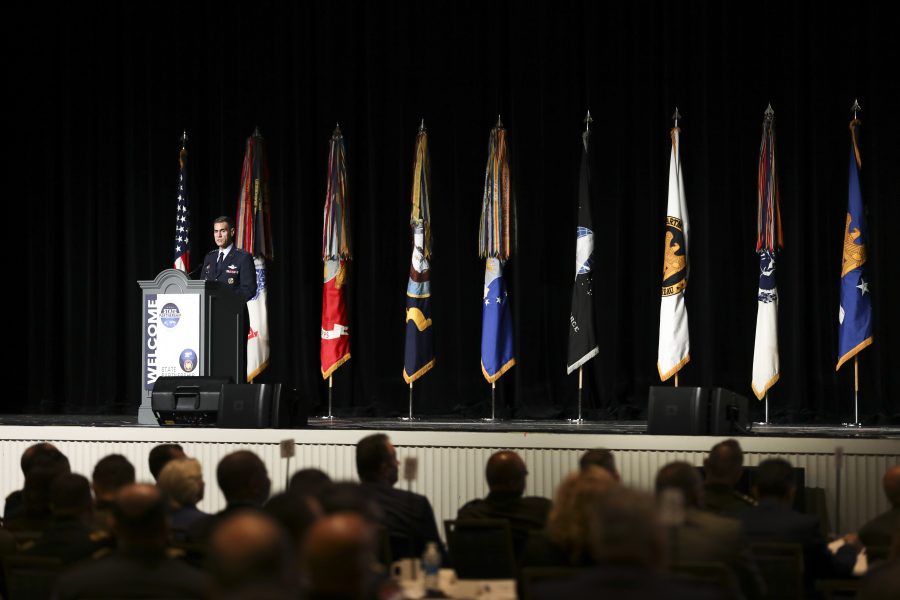Thirty years ago, the National Guard Bureau established its State Partnership Program (SPP) by pairing 13 former Soviet bloc countries with state National Guard organizations to leverage joint training as a means of bolstering cooperation and democracy.
Today, more than 100 countries around the globe participate in the program, with 88 active partnerships. All 54 states, territories, and the District of Columbia have at least one partner nation. And as officials gathered for a conference at National Harbor, Md., to celebrate the anniversary, they also laid out a vision for the future of the program—one focused less on expansion and more on deeper cooperation covering more capabilities and domains.
“The future is not going to be, ‘Let’s do another 100 countries in 30 years, slap the table, and call it done,’” said Maj. Gen. William Zana, director for strategy, plans, and policy at the National Guard Bureau, during a panel discussion. “It’s really a different evolution, and a different set of processes in progress that we’re going to have to see.”
Several days earlier at the Pentagon, Zana told Air & Space Forces Magazine the program historically focused most on land forces. But more recently, he said, “We see a tremendous increase in the partnerings across Air Force and Air Guard, and I think we just expect that to continue.”
Lt. Gen. Dan Cain, associate director for military affairs at the CIA, recalled in a keynote address, his experience with the Georgia Air National Guard, traveling to “fly together with the Argentine Air Force and learn, grow, and trust each other in a new and different way.”
Future partnerships could even extend into space. More than 1,000 Air National Guard members spread out in six states support space missions, and while lawmakers are still debating whether to create a separate Space National Guard, more and more countries are getting involved in space.
“We absolutely see a demand signal from our partners and an opportunity to work with them much more closely on space,” Zana said. “We see that at scale and at different levels. Different nations are either directly involved in some of the things that they want to do for their own interest in terms of space, or other nations, in some cases, adversaries, have an interest in their capabilities. So it's a great opportunity for us to both learn, grow, and share with partners.”
Deeper partnerships across those areas could be crucial to bolstering partner nations in strategically important areas like Eastern Europe, the original focus of the SPP, and the South China Sea, where the Philippines, Vietnam, Malaysia, Thailand, and Indonesia are all part of the program now.
“I have to admit that we see this state partnership program promoting the strategic message that the U.S. is interested in the Black Sea region, the region where a war is happening right now,” Romanian chief of defense Gen. Daniel Petrescu said in a panel discussion. “So we start with the mission, and I believe we should look also at the strategic environment. … We are at an inflection point right now. And maybe the way we created this state partnership program in the '90s, in the former Warsaw treaty countries, getting them to move towards democracy, maybe the next step will be [teaching] these democracies how to defend against challenges and build the capacity.”
The SPP has earned plaudits for the ties it built between Ukraine and the California National Guard, ties that have proved invaluable as the Ukrainians have fought off Russia’s invasion. Moving forward, officials say they want to build more such ties—and increase interoperability in case of a conflict.
“When you look across the landscape, [there’s] a continued desire for speed and depth of interoperability,” said Vice Adm. Stephen “Web” Koehler, director for strategy, plans, and policy for the Joint Staff, in the panel discussion. “And I know that's what everybody wants, but as we get to having, one, the ability to deter, and, two, should that fail, get ready to get after a conflict, those things need to be done before the conflict. So as we talk about a surge in trust, that comes with interoperability and depth thereof.”
Building those connections does not come without cost, said Air Force Maj. Gen. Paul Knapp, adjutant general of the Wisconsin National Guard. “Predictable and stable funding is critical for the State Partnership Program and coordinating across different fiscal years. Our fiscal year is probably different from the fiscal year of the country that we're a partner with, and providing that predictable funding will allow us to have more stable events and engagements."
U.S. Guard units must also be sized to be able to support that growth, he said, adding: As the U.S. builds additional partnerships, "I think it's important for us to attempt to gain additional force structure and staffing in the states in order to adequately manage those partnerships.”
